The Article
R-N602 From Yamaha: On The Receiving End
19th October 2016
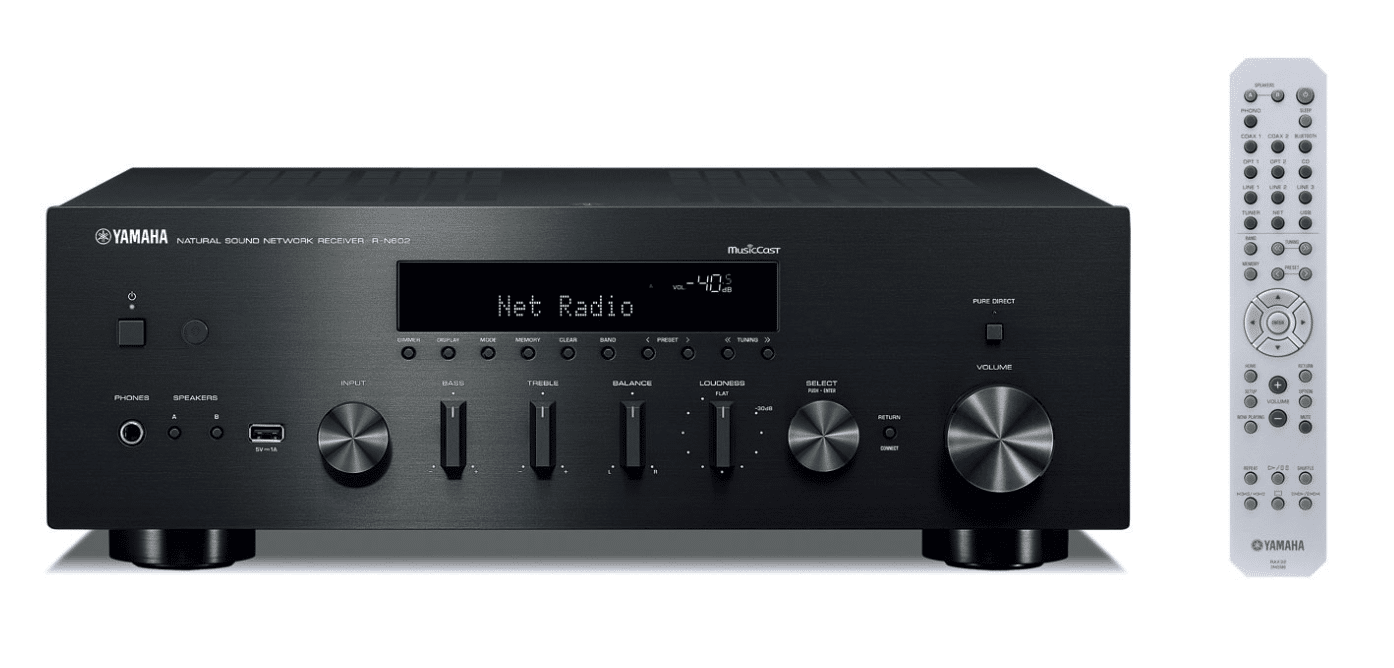
Sporting a retro amplifier design but packing in numerous digital and networking facilities, Paul Rigby reviews Yamaha’s budget receiver, the R-N602
It’s big, it’s meaty, it’s got buttons and switches and knobs and it’s shiny (silver) or its so dark that light falls into it (black, what else?) and you could put caterpillar tracks underneath it and invade a small neighbouring country without a shot being fired because the populous would run away from it, hands in the air, screaming hysterically. This is Yamaha going back to its 70s roots. You don’t look horizontally at the R-N602, you walk up to it, pause, then you lift your head slowly and see if you can make out the summit…somewhere in the clouds.
You also don’t turn on a 115W R-N602 via the on/off button, you send it a letter of introduction and then wait for permission.
While doing so, you can note that the R-N602 is designed to be used as part of Yamaha’s MusicCast network audio system that allows you to use all your MusicCast products together or separately, controlled from one app which, of course, also means popular streaming services (where applicable in supporting countries) such as vTuner internet radio, Pandora, Rhapsody, Spotify, SiriusXM, Napster and Juke. On the networking subject, the ‘Yammie’ also supports AirPlay, DLNA plus Digital Blocking (an iPod’s direct signal is sought feeding the Yamaha’s own DAC). An ECO mode reduces power by 20%, you have access to Bluetooth, Wi-Fi plus a Pure Direct button to bypass the majority of the amp’s electronics to enhance sound quality.
In terms of files support, the Yamaha supports 5.6MHz DSD and AIFF 24bit/192kHz, WAV/FLAC 24bit/192kHz plus the usual suspects via a Burr Brown DAC. There’s also a FM/AM tuner, speaker terminals for two systems and, oh yes, the ability to plug a turntable directly into the box because you get a phono amp, built-in. More about that later. Other sockets around the back, apart from plentiful source RCA-based connectors, include two opticals, two coaxial, a wireless port for a screw-in aerial plus the ability to connect Ethernet and a subwoofer.
IN USE
It’s bulky, retro and clunky. In fact, the hefty and expansive Yamaha glories in its retro clunkiness. It comes at you, arms open with that certain ‘look at me!’ exclamation as it displays hulking great knobs that control those old classic controls: treble, bass, balance and, don’t forget that old favourite, ‘loudness’, sitting next to more modern additions such as the USB source socket. Some might question the inclusion of such controls and I would agree that the treble/bass/balance/loudness quartet are worse than useless. That said, the Pure Direct removes any criticism because it allows the sound signal to skip right past them. Hence, their inclusion could be seen as ‘a bit of fun’. In these design terms and for this price…sure. Why not? The target audience, many of which will be maturing beginners with hi-fi experience that relates to their parents old system, may even see the inclusion of such controls as a comforting familiarity.
SOUND QUALITY
I began by spinning Buffalo Springfield’s For what It’s Worth (1966) on the Leema Elements CD Player. Three things hit me immediately. Firstly, the bass was very strong and punchy. Yamaha likes its lower frequencies and the performance here maintains the house sound which means that this track offered excellent bass force and foundation. The song was driven throughout with a strong rhythmic drive that gave the track an enhanced sense of pace.
There was a lack of engagement, though. By that, I means that the soundstage did sound a little stark. It was almost as if the guys played in a studio that was, by day, an operating theatre. There was a slight lack of soul and musicality in the R-N602s presentation so that the drums never really connected with the guitars or the emotional vocals. Then I noticed that the Pure Direct button had not been engaged. Turning this feature on bypassed much of the amp to provide a more direct sonic pathway. This improved the sound quality immeasurably, giving the vocals a more, well, human quality with delicate textures from the vocal chords more in evident while the guitars offered greater grit and involvement. Despite the good news, though, a certain analytical edge remained but the effect was greatly reduced in Pure Direct mode.
The sense of clarity from the upper midrange and treble enhanced the tonality of the music while there was tremendous instrumental separation around the soundstage so the band sounded relaxed and at ease with their playing. There was never any sense of tension. The air and space exhibited also gave the frequencies time to decay properly which enhanced the performance of these organic instruments, increasing detail.
These days, I only tend to handle MP3 files with rubber gloves and a pair of forceps but playing Kylie Minogue’s All the Lovers from her Abbey Road Sessions album in this execrable sound format sounded half decent via my Apple iPhone 6S over Bluetooth. There was plenty of room to be had while midrange and bass existed in an admirably balanced manner. Strings were thin and nasty, yes while Minogue’s vocals made her sound like she had a pinched face (I imagined her as the green-faced witch in the film, The Wizard of Oz, MP3s made Kylie sound just like that) but, even given the lack of musical data, the Yamaha performed tremendously to give you the best performance it could. As if the amp was exclaiming, “Look, guv, I haven’t got much to work with here…but this is the best I could do.” I’ve heard a lot worse, even via equipment price higher than this receiver.
Using a USB stick, I played the DSD version of the Allegro for Bach’s Concerto for Harpsichord, Flute and Violin via the front loading USB port and was pleased to hear the relatively spacious digital performance of the R-N602 continue here. Strings and the wind section did sound a little thin and slightly forced, though, even at this high resolution. The performance basically allied itself to the earlier CD tests, in this respect. That said, there was much to admire with the informative nature of the track giving this textured and detail arrangement time to manoeuvre while allowing complex instruments such as the harpsichord a chance to express itself.
Up until now, we had a reasonable digital power house that looked great on paper but offered no more than a ‘credible’ performance in reality.
Then something wonderful happened.
I wanted to test the internal phono amp of the Yamaha. At this price, it is more likely that users will be utilising the internal module and not spending out for an external phono amplifier. Pushing an analogue signal through this unit was fascinating because the results were surprisingly good. The slightly sparse nature of the presentation combined with the epic quality of the phono amp and the warmth of the basic vinyl signal to provide a big, bold, open and grand musical return. Trumpets sounded clear and brassy without a hint of stridency or brightness, saxophones were reedy and emotive, vocals offered a precision and enhanced diction and bass was firm, fast and informative. This heady mixture was quite a sonic revelation for the price!
CONCLUSION
The Yamaha R-N602 offers plenty of value for the money and a wide array of features with an appealing retro design. Despite the slightly constricted digital response in CD and general digital file terms, I was blown away by the analogue play and can whole heartily recommend this amplifier if you are looking for an amplifier to act as the heart to your vinyl hi-fi system.
In fact, I would go further than that and advise you not to look at this box as a multimedia receiver at all. Me? I would not buy it for its digital features. I would turn the feature list on its head. I would see this product as the amp section of a new vinyl system with plenty of bonus digital features added on because even if you saw the Yamaha as nothing else but a vinyl-based amplifier, it would still be good value. Anyone looking to set up a budget vinyl system really needs to place this box on their demo list and pronto.
YAMAHA R-N602 RECEIVER
Price: £339
Web: uk.yamaha.com/en
Tel: 01908 366700
For more specifications, click HERE
GOOD: Pure Direct mode engaged, open and natural phono output, feature count, Bluetooth, price
BAD: Pure Direct Mode disengaged, digital playback
RATING: 7
REFERENCE SYSTEM
Rega RP3 turntable
Leema Elements CD Player
Rega Brio-R amplifier
Spender S3/5R2 speakers
Chord Shawline cables

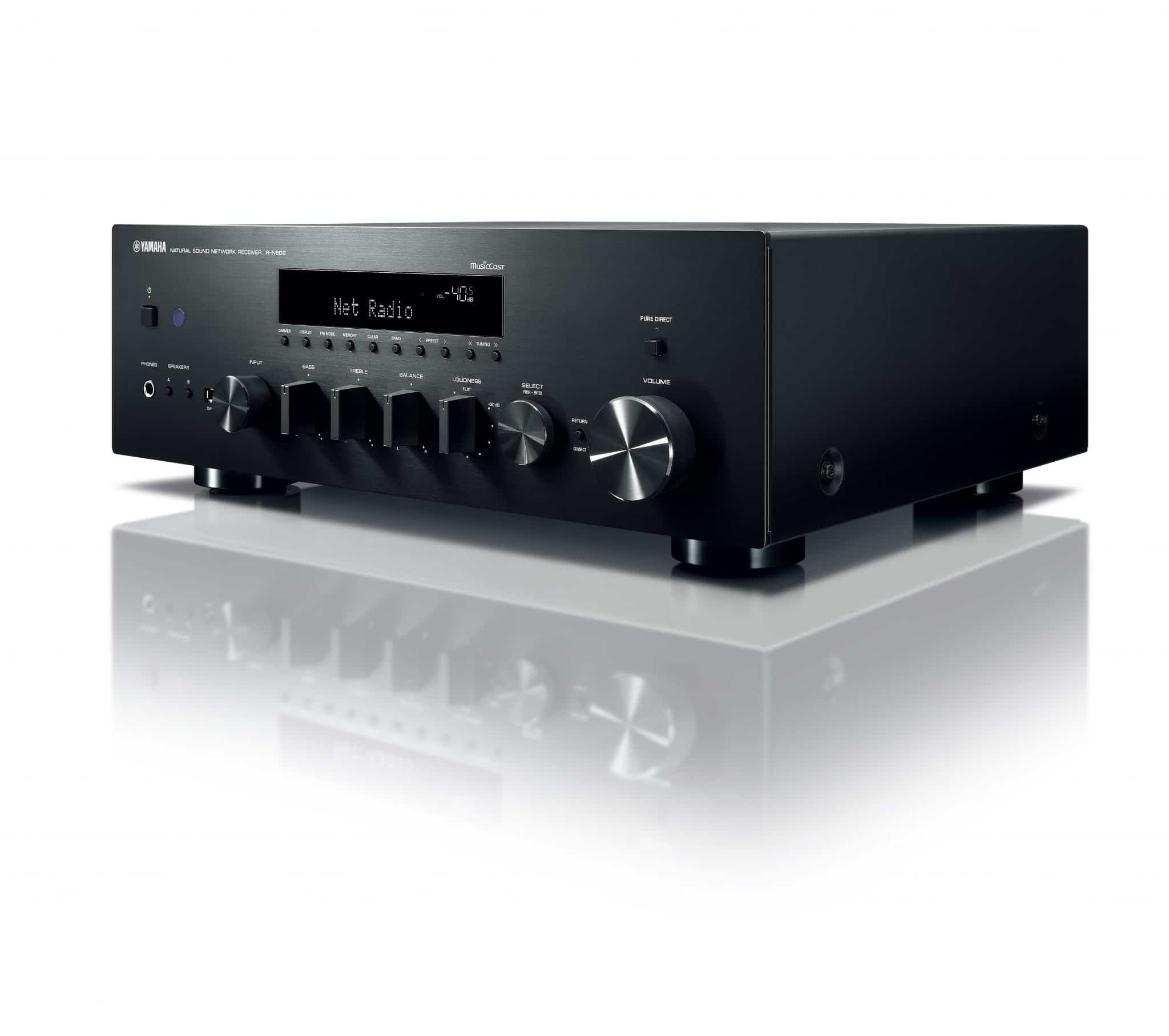
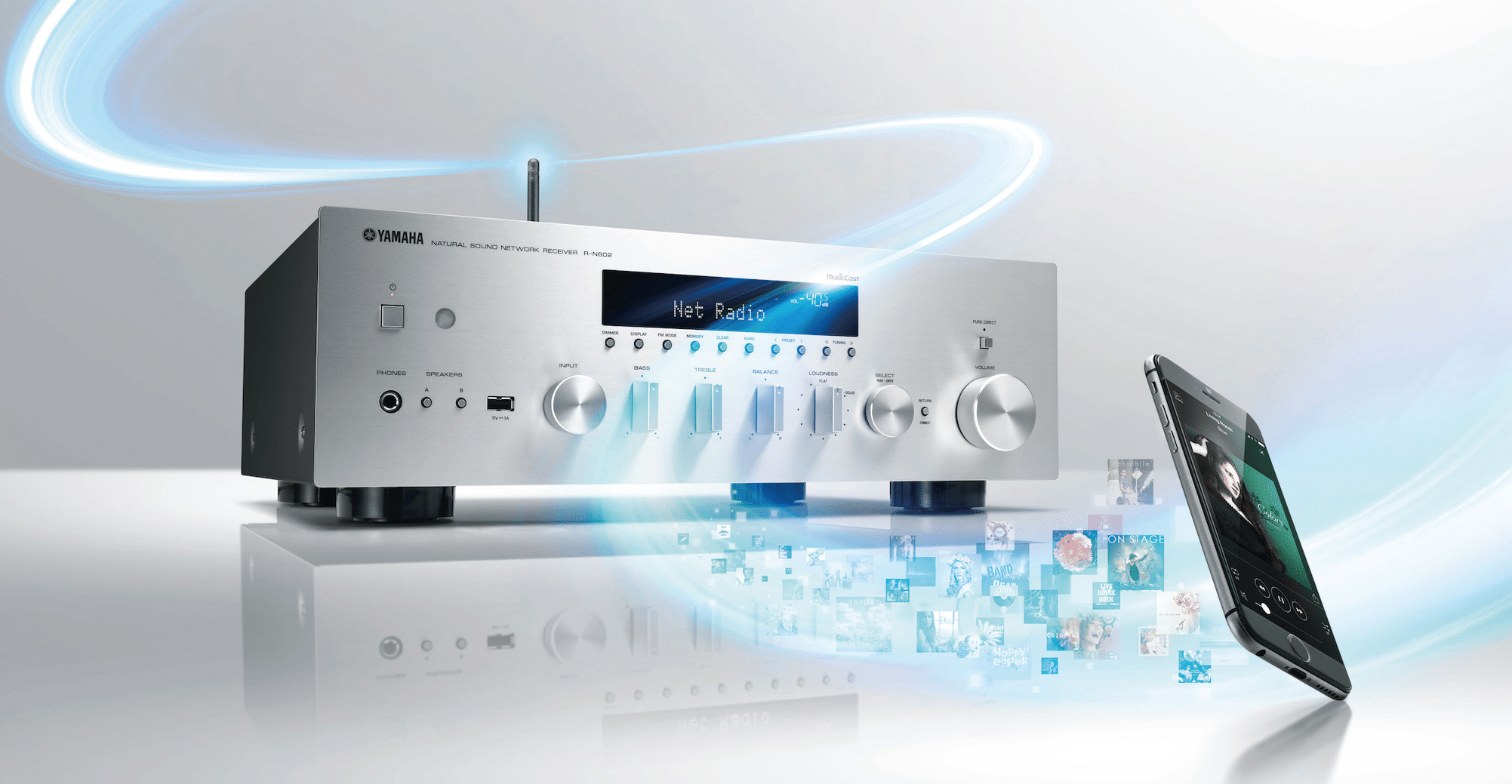
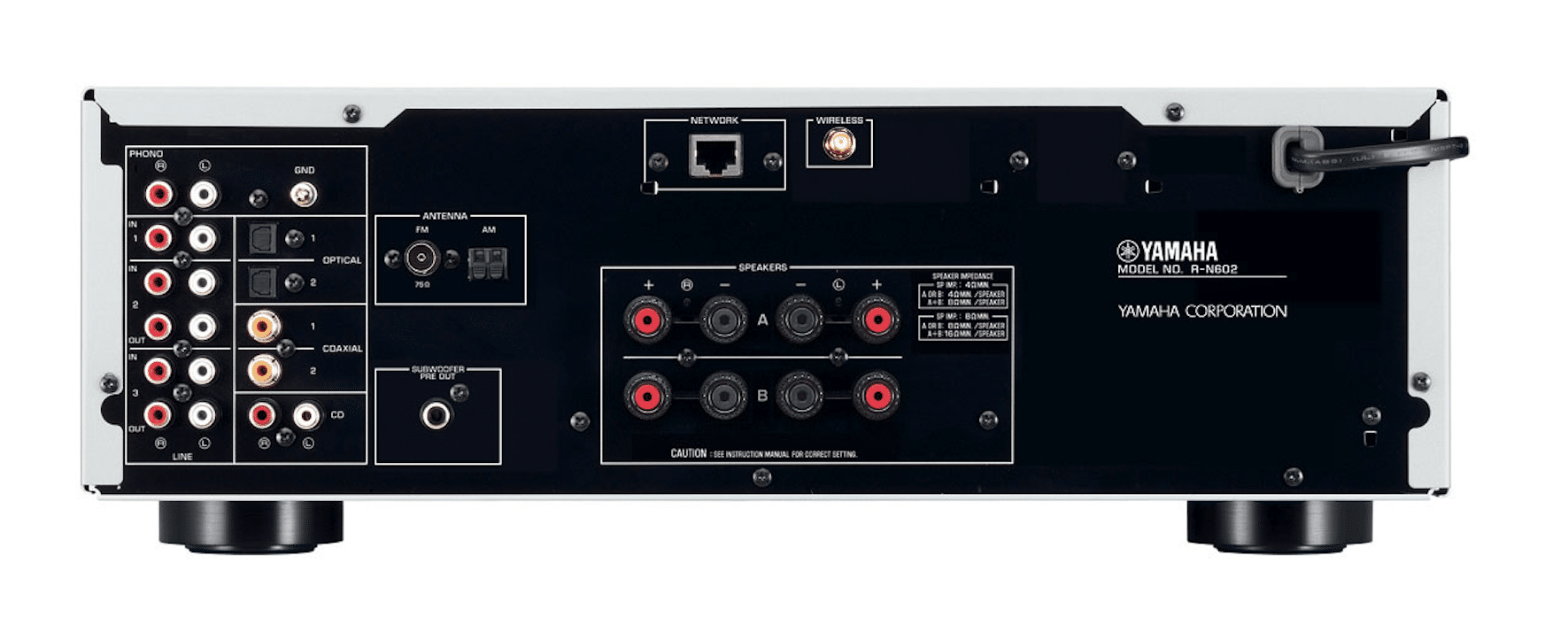
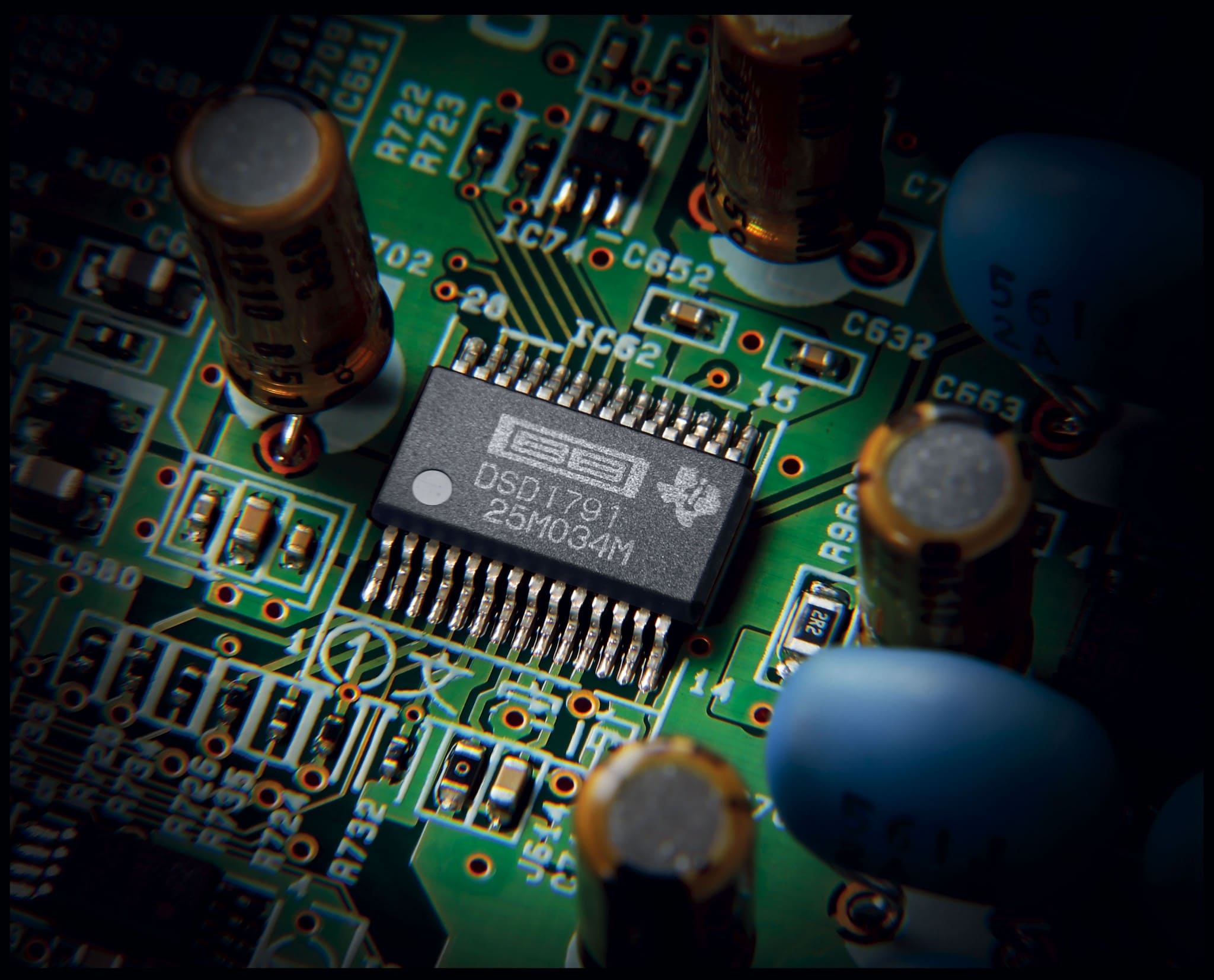
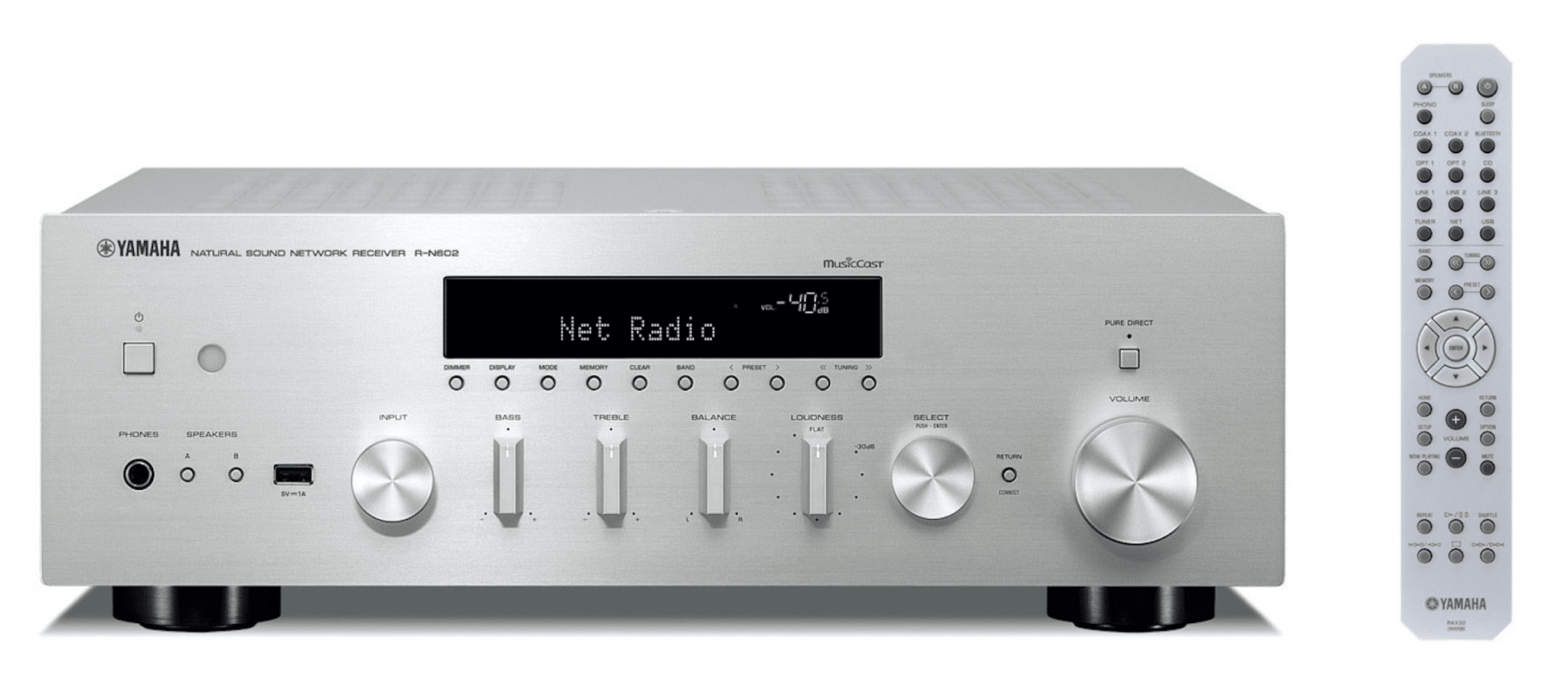


Hi Paul,
Fiio has a 3.5 headphone jack But the same can be set to get line out (I never tried though). I was wondering using in-built USB, are we getting better sound because of minimum signal loss and or better matching to amp.
If so it would be one justification spending extra for the model having in-built usb.
I would highly recommend using the line out option via the headphone jack to improve sound on your Fiio, yes. The USB on the Fiio is for charging only, I think. For the Yamaha, the USB port is well worth pursuing, yes, if you have something compatible to plug in.
Hi Paul,
I just bought this receiver. I have one question regarding DSD playback. I have got few sample files in .dff and dsf format (DSD64 i believe) but receiver seems not to “see” these in my shared music folder. It does play mp3 and FLAC files located in the same place on my PC though. I also tried to copy these DSD files onto my phone and connect via USB but with no luck. Not sure what I am doing wrong.
Hi Maciej
Have you been able to play these DSD files anywhere else? Are the files themselves ok? If so, copy the files to a USB stick and try to play it/them from there. After that, try and play them from an external hard disk, if you have one. Then come back and let me know how you got on. Could possibly be a PC issue.
Hi Paul, I was wondering if this receiver is good in combination with the Yamaha 2700 soundbar. I’m not having space for speakers with 2 little kids jumping around at the moment. Or is this combi too much the same,and waste of money? I will use it mostly for Radio / Stream (music),
That’s a moot point, Martijn – I’m not a fan of any soundbar, to be honest. No matter what type or brand. Too many compromises. That said, if you forced me to recommend one then it would be the Q Acoustics example: https://www.richersounds.com/q-acoustics-m4-blk.html (I’m not recommending the retailer, this information is just for your reference). It includes Bluetooth.
Hi Paul! I just bought this Yamaha RN602. As your review says, you seem to really like the phono amp on this one. When I plugged my Akai turntable in, I noticed a HUGE sound level gap between the analog and digital (spotify). The digital sounds 2X louder than the analog… I tried it with my brother’s Technics turntable and I got the same results… Did you experience the same issue?
There’s a host of possible reasons for this – did you try other digital sources, incidentally? One good reason may be the compressed nature of Spotify streaming which will give the impression of a higher gain/volume while the lesser or zero compression on a purer and higher quality analogue source signal will give the impression of a lower gain/volume. Connected with this, noise in a signal can produce seemingly higher gain. This is one reason why your vinyl records sound a lot better than a Spotify stream, there’s less noise to mask the finer detail on offer via analogue.
I tried with all other digital sources, cd player etc… and they pretty have all the same sound level. I really think there’s an issue the analog build-in amp with my receiver… Not only the sound level is much much lower but it also seem muffled… You didn’t experience the same problem during your tests?
Not with my hi-fi chain, I’m afraid Dominic. There may be a technical issue, certainly. It’s difficult to tell at this distance, of course. Have you checked other components in the chain including cables, etc? Have you tried simple things like disconnecting and reconnecting, switching off – waiting – then on again? Sometimes the basics can bring surprising results. If the lower sound gain occurs with a turntable, have you been able to try another turntable and/or cartridge? The issue could be with that.
Hi Gentlemen, I recently purchased the Yamaha RN602 to use in conjunction with a TEAC TN-3B turntable with an upgraded Audio-Technica VM95SH stylus, played thru a new pair of Canton GLE 496.2 floor speakers. My impressions are the same as Dominic’s, you really have to crank up the volume for the phono input to produce the same vilume level compared to the USB and net radio inputs. The phono sound is great, but it seems to me that the integrated amplifier perhaps does not have enough oomph to drive my speakers as well at lower volumes. Don’t get me wrong, I can still piss off my neighbors if I crank it up, and the system sounds pretty respectable, but I was wondering if I could possibly use an external preamp for the turntable, and plug it into one of the other input lines to bypass the Yamaha preamp and get a more powerful and richer sound? If not, I am still very happy with this receiver. The digital music sounds fantastic! Also, I disagree about the manual bass, treble, balance, and flatness adjustments as opposed to the Pure Direct mode. I find that the manual controls help me to tailor the speakers better to the 18 x 35 foot basement with less brightness and better bass and mid-tones . Maybe it’s just the speakers. Thanks for your great reviews!
hello paul
i have one of these receivers and i am wondering can you get a signal from the out jacks on line’s 2 and 3 and plug them into another line on a different amplifier ? like a tape loop.if not how exactly do the out’s work? and what can you connect to them to get a signal.
many thanks
jay
This reply is direct from Yamaha, Jay: “I can confirm that you will need to select either input 2 or input 3, to listen to your preferred device. Then the attached output (out 2 or 3) will output just that device.”
Hi Paul
Nice review, I also read your review of the Yamaha WXA-50 and I’m undecided between that and this R-N602 and would be interested in your opinion of which is better as I’m having trouble finding anywhere that has both available to listen to. I like the small form factor of the WXA-50 but if the R-N602 sounds better I’d happily go with that. I listen to pretty much just Spotify (rock, jazz, classical) and internet radio (6 music and radio 3). You’re not very complimentary about the 602 for digital music. I have Tannoy Arena 5.1 speakers (with an old Yamaha receiver) but am possibly going to change to stereo speakers: Monitor Audio Bronze 2, Q Acoustic 3020i or Dali Zensor 3 (or just keep the 2 front tannoy speakers and the sub) – interested in your view on that and any other suggestions welcome, budget is ¬£300-¬£400 for the Amp and around ¬£300 for the speakers. Many thanks!
Thanks for your question Julian and your kind words. As a choice between the two Yamahas from a digital perspective, then yes I’d go for the smaller units with a pair of Q Acoustics.
I’ve 3 Yamaha receivers (stereo) rn-602, and 4 Yamaha speakers ns-777. They are all its boxes. The stereo Yamaha have a way to put it in 4 ohms, instead of 8 ohms. The Yamaha speakers ns-777 are all 6 ohms. Do anyone here can answer if it will be possible to do it? If it’s not, please, explain. I have only stereo receivers here, like 2 Pioneer SX-1980 moving my 8 JBL S-312, but the Pioneer is a monster and I only can use 4 volume (very low, but very loud), and its volume goes to 30… So, because if very difficult to maintain my Pioneers clean and okay (in Brasilia, Brazil, where I’m living for 20 years, there’s no one person to do its maintenance or to maintenance my JBL S-312 (the city of Brasilia has 3.3 millions inhabitants — but no one knows about big speakers neither big receivers).
So, I decided by my own to buy Yamaha Stereo Receivers r-n602 (I didn’t find the r-n803 for 2 years –but now I think I can buy one, new) and to buy Yamaha speakers NS-777. I love bass, and use all bass and Loudness since 55 years… Why some people say it’s impossible to connect the Yamaha r-n602 (even using 4 ohms) to 4 speakers (Yamaha ns-777). What would be the problem?
Hi Gabriel – this is from Yamaha…
“If the customer would like to plug in x4 speakers and have them play at the same time we recommend the following:
Connect speakers with a nominal impedance of 8ohms or higher when both SPK A B terminals are being used at the same time. – when using 4 ohm SP IMP Setting on amp
Connect speakers with a nominal impedance of 16ohms or higher when both SPK A B terminals are being used at the same time. – when using 8 ohm SP IMP Setting on amp
What would be the problem?
A lower ohm speaker means that the amplifier will attempt to deliver more power through its circuitry and components.
It may still work and sound impressive, but it will make the amp run hotter and will reduce the products life span.
Thanks for the nice read and all the effort in the feedback here.
I’d be really curious, if you speak to the yamaha types again, if they have any plans to ever put some crossover control in a stereo amp, without the rather ridiculous method of using an app, like on the r-n803.
Why on earth can’t stereo makers just put this obvious, cheap feature on board. I mean, literally dozens (or more) of us have subwoofers, fer feck sake. 😉
Thanks for your kind words Jeff and – yep – I’ll certainly pass that one on 🙂
Sorry for the delay with this, Jeff, this direct from Yamaha, “…currently the R-N803D is the only Hi-Fi product with Subwoofer X-Over adjustments. To my knowledge we currently do not plan to include X-Over adjustments outside of the app. This is something I will be reporting back as a feature to be added on future models. On a side note, to achieve the best pairing between a Hi-Fi amp & a subwoofer, I would advise to use a hi-level connection (if the subwoofer supports this) with the subwoofers X-Over dial on the back, as this usually enables finer X-Over settings rather than 20Hz / 10Hz / 40Hz steps like on the app & AVRs.”
Hi Paul,
I’ve bought 3 Yamaha n-r602 and 2 Yamaha n-r803, and 4 Yamaha speakers NS-777.
The Yamaha NS-777 are all 6 ohms.
Can I connect one of my Yamaha receiver (the 602 and the 803) to 4 Yamaha NS-777 (6 ohms)?
But it’s better to change the ohms of the Yamaha stereo Receivers (602 and 803) to 4 ohms or to 8 ohms (I think my Yamaha’s Receivers don’t have 6 ohms to set).
Because I’ve another Yamaha, the R-S700 and 4 JBL speakers 8 ohms, I put it in 8 ohms and it is very good to hear the sound (the way to hear blues, modern electric blues, funk, classic music (Bach on organ, on Piano etc.), dark and what kind of music (my JBL can start at the low frequency of 35Hz each one).
The Yamaha NS-777 (they say it has a lower frequency, like 28Hz) are 6 ohms, and I can’t change that.
What I have to do to hear 4 speakers with receivers that I can put in 8 or 4 ohms.
I would like to connect the 1 (one) Yamaha Receiver (the R-N602 or the R-N803) with 4x Yamaha NS-777 (6 ohms).
What I have to do??? Put the Receiver in 4 or 8 ohms with 6 ohms speakers?
Someone answer part of my question: put the receivers into 8 ohms.
But what will happen to the receivers, they will be overheat? I have to use more air-conditioners and vent it to avoid heat the receivers?
Why not put the Yamaha Receivers into 4 ohms instead of 8 ohms?
All my 5 Yamaha receivers are boxed yeat, and the Yamaha speakers too.
I did not read the manuals.
So, 4 or 8 ohms for Yamaha stereo receivers to run 4 Yamaha 6 ohms speakers?
Thanks.
Hi Paul
Can I connet 4 Audio Monitor CL50 speakers and 1 Polk Polk Audio
sub woofer DSW PRO 55OWI to this amp without the amp getting overloaded and tripping?
Looking the manual, that shouldn’t be a problem Rohit.
THANKS A LOT….APPRECIATE YOUR HELP AND ADVICE.
Not a problem Rohit.
Dear Paul, many thanks for the detailed review. I see that a similar question has already been answered higher, however, I think I have a slightly different perspective here. I am choosing between WXA-50 and R-N602. I have heard quite different opinions about both pieces of equipment but had a chance to test only WXA-50 at an audio shop, so cannot judge by myself which one of them is better. They both offer very similar versatility as regards WIFI connectivity, streaming music from Spotify etc. I would bet that R-N602 bosts better sound naturally as it is a bigger receiver and one cannot fool the physics (apparently). Nonetheless, I have been told that WXA-50 sounds better due to a better DAC (and that the same DAC can be found in R-N803). I wonder whether this really is the case – what is your opinion? Now I am looking at an offer featuring WXA-50 with Wharfedale Diamond 230 floorstanding speakers. Is it able to handle these floorstanding speakers? Or should I need the additional power of R-N602 for them? Many thanks in advance!
Hi Edvƒ´ns – both Yamaha products are not perfect and both have pros and cons but if digital is your preferred source then, yes, the 50 is my preferred option. The speakers should be fine with the 50.
Hi Paul,
Just looking to replace an aging hi fi system. I want to get out my vinyl again. Would the Yamaha R-N602 be a good match for a Rega Planar 2? I’m also looking to use it to airplay CD’s from iTunes. Thanks
Yes, shouldn’t be a problem. When you can, grab an external phono amplifier. The Rega Fono for under ¬£100 is a good choice.